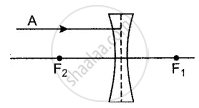Advertisements
Advertisements
Question
(a) Find the position and size of the virtual image formed when an object 2 cm tall is placed 20 cm from:
(i) a diverging lens of focal length 40 cm.
(ii) a converging lens of focal length 40 cm.
(b) Draw labelled ray diagrams to show the formation of images in case (i) and (ii) above (The diagrams may not be according to scale).
Solution
(a) Object height (h) = 2 cm
Image height (h') =?
Object distance (u) = -20 cm (sign convention)
(i) Focal length (f) = -40 cm (sign convention)
Image distance (v) = ?
Applying the lens formula:
`1/v-1/u=1/f`
`1/v-1/-20=1/-40`
`1/v+1/20=-1/40`
`1/v=-1/40-1/20`
`1/v=(-1-2)/40`
`1/vv=-3/40`
∴ `v=-40/3=-13.33` cm
Negative sign shows that the image formed is virtual and erect.
Now, magnification m =
`v/u=h^'/h`
`h^1=v/uxh`
`h^i=(-13.33)/-20x2=1.33`cm
Height of the image is 1.33 cm.
(ii) Focal length (f) = 40 cm (sign convention)
Image distance (v) = ?
Applying the lens formula:
`1/v-1/u=1/f`
`1/v-1/-20=1/40`
`1/v+1/20=1/40`
`1/v=1/40-1/20`
`1/v=(1-2)/40`
`1/v=(-1)/40`
∴v=-40 cm
Negative sign shows that the image formed is virtual and erect.
Now, magnification =
`v/u=h^'/h`
`h^'=v/uxh`
`h'=-40/-20X2=4cm `

APPEARS IN
RELATED QUESTIONS
Explain with the help of a diagram, why the concave lens is also called a diverging lens.
Define the principal focus of a concave lens.
Where must the object be placed for the image formed by a converging lens to be:
real, inverted and smaller than the object?
If an object is placed 21 cm from a converging lens, the image formed is slightly smaller than the object. If the object is placed 19 cm from the lens, the image formed is slightly larger than object. The approximate focal length of the lens is ______.
Draw a diagram to show how a converging lens focusses parallel rays of light?
Fill in the following blank with suitable word:
Lenses refract light to form images: a..................... lens can form both real and virtual images, but a diverging lens forms only ...................... images.
Construct ray diagrams to illustrate the formation of a virtual image using a converging lens,
Where will the image be formed if an object is kept in front of a concave lens at a distance equal to its focal length? Draw a ray diagram to illustrate your answer.
In figure give below of thin concave lens, F1 and F2 are its foci, complete the path of the given ray of light after it emerges out of the lens.

Convex lens : converging : : concave lens : _______
